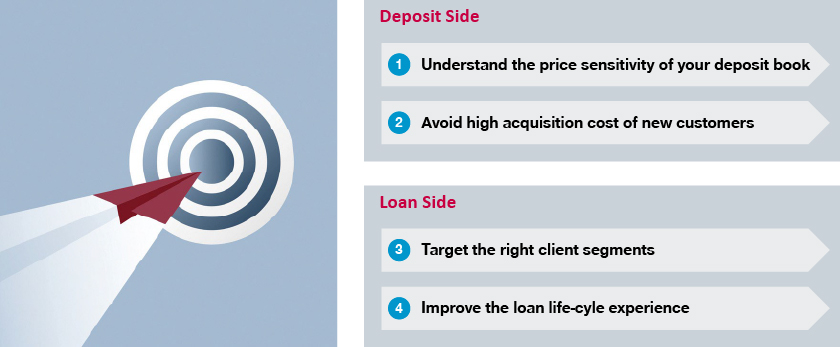How Hong Kong banks can manage interest rates holistically across both sides of the balance sheet.
In line with the recent interest rate hikes by the Federal Reserve, on May 4, Hong Kong’s Monetary Authority (HKMA) set the base rate to 5.5 percent - the highest rate since 2008.
In parallel, the HKMA withdrew liquidity from the banking sector to maintain the peg to the US dollar, resulting in a rise in the Hong Kong dollar interbank offer rate (HIBOR). The HKMA’s repeated interventions to maintain the currency peg to the dollar drained the interbank liquidity to a level not seen for 15 years.
The rising interest rates enabled banks to post record profits in their cash management and retail banking businesses. However, times ahead will be more challenging as low liquidity levels in the interbanking system and the rising HIBOR will take their toll on both sides of the balance sheet.
Why a high HIBOR and low liquidity in the interbanking market will slow down business for Hong Kong’s banks
- Higher cost of funding
The HKMA’s reduction of interbank liquidity is forcing banks to find additional funding. The cheapest source for banks is usually deposits. However, as banks haven’t passed on the full interest rate hikes for deposits, clients have started to seek higher returns elsewhere. To attract additional funding, banks must offer higher deposits rates, which in turn raises their cost of funding.
- Slowdown of loan growth
The majority of mortgage loans are pegged to the HIBOR. Therefore, any increase in the rate affects loan costs for clients directly. In such an environment, new customers (e.g., mortgage customers or small businesses) are less inclined to lock their financial future into loans at higher prices, and existing customers strive to decrease their financial burden through higher repayments. Loan growth is being further inhibited by investments from mainland China and the slow recovery of the domestic economy.
- NIM compression later this year
Future interest rates hikes by the Fed and additional currency interventions by the HKMA enhance the effects for deposits and loans. On the deposit side, higher interest rates are required to attract additional funding. The result is higher cost of funding. On the lending side, a high HIBOR increases the income for the bank but limits loan book growth. Accordingly, the net interest margin (NIM) is compressed.
Action plan for Hong Kong banks as interest rates rise

With these latest developments, it is paramount that Hong Kong banks manage their cost of funding and loan books diligently.
Deposit side
- Understand the price sensitivity of your deposit book
Create transparency on your deposit book and identify price elasticities. Knowing how customers have reacted to price changes in the past can help you identify patterns in price sensitivity among different segments. This allows you to run simulations to determine the right products and prices for each client segment. Volume targets per client segment enable you to maintain deposit levels.
- Avoid high acquisition costs for new customers
It may be tempting to match market rates for deposits without differentiation. However, this would result in unnecessarily high acquisition costs, as all new customers would receive the same rate. A better approach is to match new customers to existing client segments and leverage the price elasticity of the respective segment to set an individual price.
Loan side
- Target the right client segments
The rising interest rates for loans will cause a higher rate of loan losses (this can be observed in the SME lending segment already). In response, banks are forced to introduce more stringent loan approval requirements, further limiting growth of the loan book. To maintain current levels, new loans meeting the new requirements must be acquired. Understanding your client segments, product preferences, risk profiles, and price sensitivities is essential for this. Identify low-risk client segments with positive spare cash flow while taking higher HIBOR and prime rates into account and focus your lending on these segments.
- Improve the loan life cycle experience
Loan applications are usually tedious for new customers, creating a barrier to successful submissions. This barrier can be lowered using digitalized processes with gamification components. These could include quizzes about financial literacy or games to teach financial concepts. In addition, as digital channels incur lower costs, loans submitted online could come with lower rates. Later in the loan life cycle, borrowers can be incentivized to repay their loans on time with special rewards.
Why Simon-Kucher?
In the new digital world, the best designs and concepts win. We at Simon-Kucher have extensive experience in digital platforms, dynamic pricing, and behavioral analytics and can help your bank revolutionize the way you price and offer products. We have developed many innovative platforms for banks to improve customer acquisition, retention, and cross-selling by incorporating gamification elements and nudging effects.
All our platforms are future proof: Our comprehensive monetization strategies aren’t limited to high-rate offers. We develop engines that forecast and recommend the best rates for efficient book management.
Interested? Check out Simon-Kucher Dynamica Deposits – our end-to-end software for data-driven deposit managers within the financial services industry.








